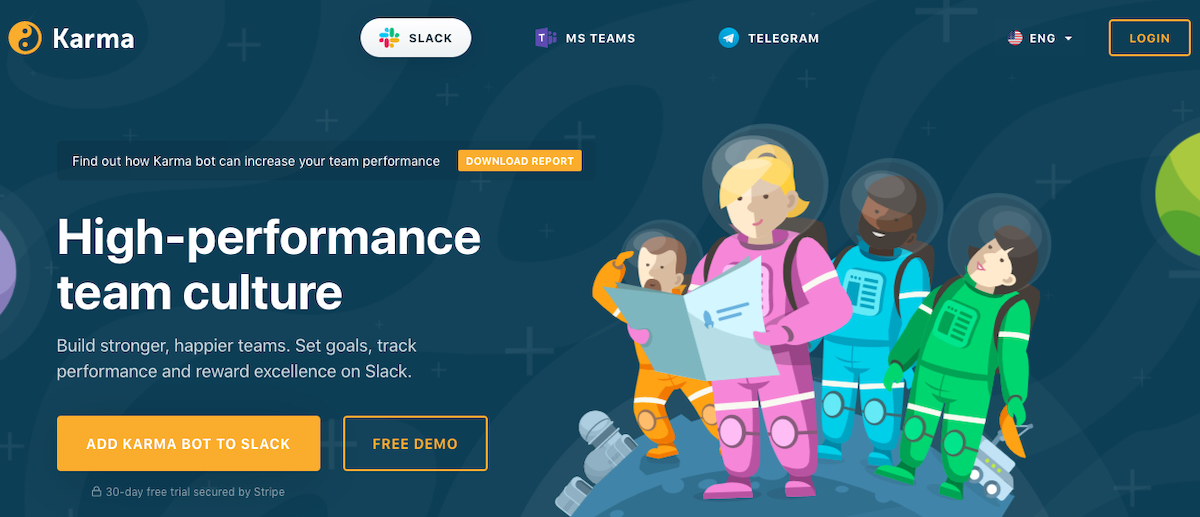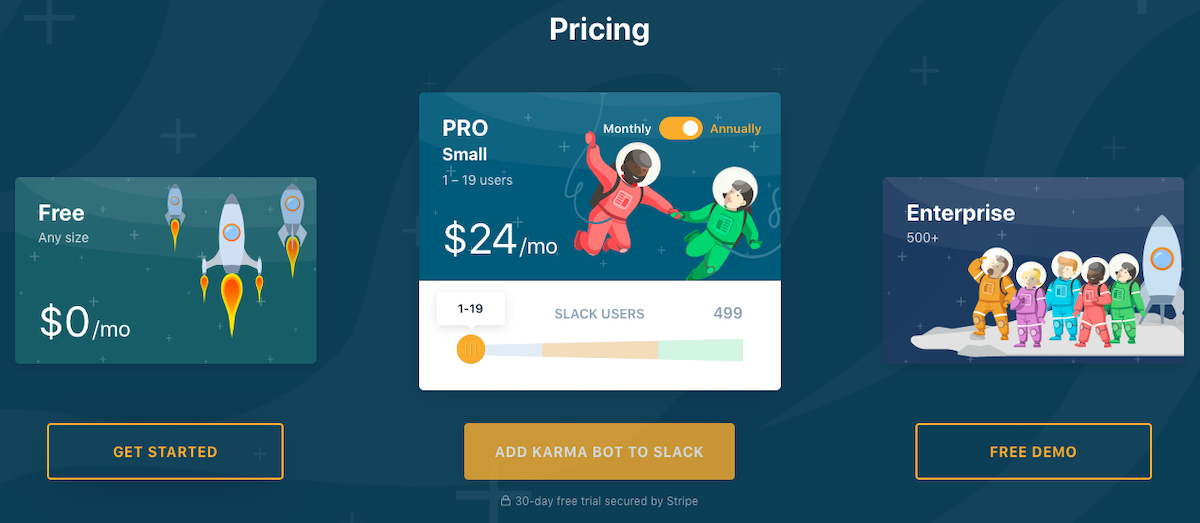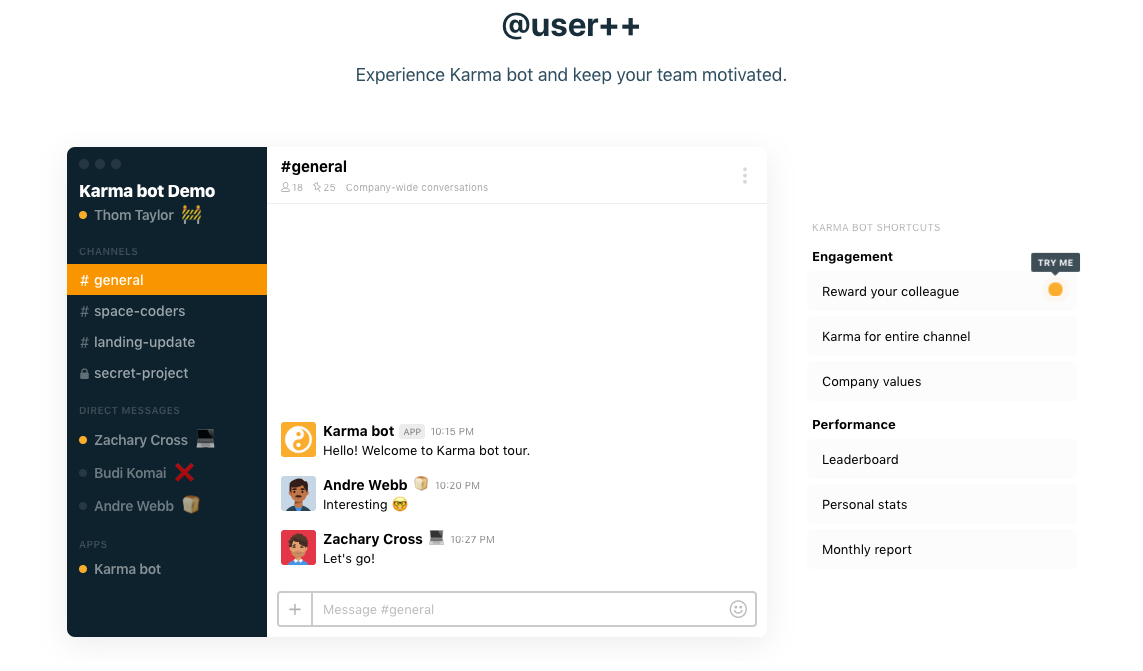How Building to Earn Drove My Product to $7.3K MRR in One Year
Hello! What's your background, and what are you working on?
Hey, I’m Stas Kulesh. I grew up in the far-eastern part of Siberia, studied computer science and nuclear physics, played in a band, got excited by indie game making, and left uni to become a digital designer. For several years in the early 2000s, I worked remotely, traveling and blogging extensively (before that became a popular mainstream thing), and ended up in New Zealand.
Nowadays, I still play various musical instruments, run a development and design shop in Auckland, invest heavily in being the best dad ever, and take care of Karma. Hopefully, Karma will be able to take care of me at some point.
Karma is a chatbot that collects and processes in-chat data to build comprehensive performance reports and improve people culture. It lifts up the team morale while providing valuable insights for team leaders. The bot is available on Slack, Microsoft Teams, and Telegram.
Karma has more than 6,000 weekly users and $7.6K monthly recurring revenue from 90 paying companies, and 750 new teams register weekly.

What motivated you to get started with Karma?
Originally, the Karma bot was an internal tool we built for our own digital studio, Sliday (team of over 24 people, mostly remote employees). After a successful Product Hunt launch, we discovered that other people wished to use it as well. For a year or so, Karma was making less than $200 per month, so we did not consider it serious enough to invest any substantial resources in, but more and more customers were asking for features and updates.
Most of the new ideas were validated internally at Sliday through our distributed development team, which, in hindsight, was probably a mistake. We should have listened more to actual real-life customers, not solely to our somewhat biased employees. As a result, the app grew out of proportion and became convoluted and hard to use and understand, difficult to explain and to sell.
We picked up the development in 2017 and went through Y Combinator's free Startup School in 2018. My business partner, David Kravitz, has been working on Karma almost full-time since November 2018, focusing mostly on sales and marketing.
YC Startup School 2018 really helped. We re-worked the pricing model, simplified the product, and made tons of improvements. Primarily, talking to customers (David does 5-10 demos a week) really helped to reshape the product and bring it back in line with where it should have been all along. The combined effort drove our monthly revenue up from $156 in January 2018 to $13,361 in January 2019.
Simply regularly tracking the important metrics (active users, amount of karma requests made, revenue, paid customers, etc.) really helps to stay focused and identify mistakes and pitfalls early. Being brutally honest with yourself is crucial. Dishonesty can, and most likely will, fly your startup into the mountain.
What went into building the initial product?
Karma is a part-time in-house project of Sliday. I design and sometimes code (front-end, mostly); David takes care of customer experience.
It didn’t take too long to build a prototype and fine-tune it for our own team needs. For more than a year, the Karma bot was primarily an internal tool. Naturally, we wanted to make this new workspace more fun and engaging, so the Sliday team would suggest a feature and together we implemented it. The transition to Slack was not easy and took almost a year. Although we made it available on the Slack store, we didn’t really invest much thought or time into keeping it relevant or attractive at all.
It’s hard to estimate the number of funds that David and I spent on this, but the time-tracking system recorded 8,308.42 hours against Karma. If one believes in the “10,000 hour” rule, we’re likely to become experts in the in-chat appreciation and engagement area in 2019.
We rolled out a major update and picked the product development up in November 2017. It took almost a year to figure out the customer base but once we did, we were able to attract more customers and get a lot more exposure. Early in 2018, Microsoft approached us and paid us $100K to develop the Karma bot for their fresh and app-hungry Microsoft Teams platform. All IP remains with us.
In terms of the team behind the product, the Sliday team consists of 20 employees. As a digital studio, we provide design and development consultancy and production services. Our top developers have been working for us for over 5 years and the preferred tech stack is Ruby on Rails, Angular.js, and Postgres. We’re shifting the front-end to Vue.js at the moment.
The core team consists of:
- UX/UI design and front-end coding: Stas Kulesh
- Karma bot app: two senior backend developers, Alexis and Victor
- Front-end: digital nomad and mentor Arkady
- QA: a part-time contractor, Max
- Illustrations: remote creative Alya from Vladivostok, Russia
David Kravitz does CX, QA, project and product management, sales, and operational work.
Together we have built over 100 digital products: web apps, browser extensions, and mobile apps. We have been one of the earliest developers on both Slack app marketplace and MS Teams bot store and gained knowledge about the platforms as they grew bigger.
How have you attracted users and grown Karma?
The initial launch went rather well. I was new to ProductHunt and the chatbot scene was rapidly growing. We kept adding more features and launching each bit as a sub-product and, as a result, Karma got featured five separate times and gathered approximately 2,500 upvotes, which helped gained the initial user base.
While Product Hunt was working okay, it didn’t really bring the customers we were interested in. Most of the early Slack adopters were startups, or small or free (non-profit) communities. They didn’t really see enough value in the product. The early adopters were ready to pay $6/mo or $99/year. While we gathered some feedback along the way, ultimately we ended up with almost 100,000 registered users and just $126 monthly recurring revenue. Laughable, really.
We tried Facebook ads and Google Adwords, but quickly realized it takes a lot of effort to set up marketing campaigns properly. These paid advertisement channels consumed more than they brought in return.
What really gave us the push we needed in terms of user acquisition was the partnership with Microsoft. Julian from Seattle HQ office lead us through the process of making bots for the Microsoft Teams chat platform, and then Microsoft helped us to test and launch Karmat on their new marketplace. To this day, the Microsoft HQ team sends karma to each other. Admittedly, the development process for Microsoft Teams is not as smooth as it could be, but the user base has so much potential as it is mostly enterprise.
We did all sorts of marketing tricks to get the message across. David and Vlad created a number of email sequences and flows at MailerLite to make sure teams learn about all the crucial features before they convert. David spent endless hours sending out cold emails — today, he’s got 12,404 emails in his Sent folder. Crisp became the chat tool of choice for instant feedback and on-site support (902 conversations). The customers really dig that kind of instant attention and connection. We strived to stay robust and flexible.
With Karma, we got accepted to Y Combinator Startup School and participated in four Pioneer tournaments. When possible, I posted on Reddit, Hackers News, all the regular geeky places. There is a Karma blog running on Medium, a Twitter account, etc.
I don’t believe in growth hacking or a one-size-fits-all scenario for user acquisition. But I am certain that if a product is solving a customer’s problems, saves time, and makes her feel better so she talks about it to her friends and colleagues — then it’s a go.

What's your business model, and how have you grown your revenue?
Karma has always been a subscription-based paid product. Initially, we set a silly $6/mo per team (any team size) price and gave away $48 lifetime licenses. Listening to the voices of reason and Startup School advisors, we updated the pricing model and stopped promising anything with the word “forever” in it.
In February 2018, we introduced freemium limited accounts in the Karma bot for Slack. Today, 1288 teams are on free. And 73 teams are paying. Stripe is an awesome — unbeatable, really — tool for billing implementation, disputes, risk evaluation, and revenue recovery.
We are a lean startup, so we try to track the costs and cut the loose ends. Today, I think, we’re paying for Digital Ocean hosting (got free credits from YC Startup School), Readme, Crisp, Satismeter, MailerLite, Stripe fees, Abstract design version control system and InVision. Stripe has been working smoothly for us since day one; we can’t recommend it enough.
Through the direct payments and recurring subscriptions on Stripe, we’re making around $5K on average, and once got to $13.3K figure when we signed a pilot project with one of the current enterprise clients.
The hardest part was to find what value people see in the karma-tracking tool. Surprisingly, the more you use it, the more value it gets. Slack acquired Atlassian’s HipChat and deprecated the product in February 2019. During that month, “karma bot” search requests and new subscription peaked. Our most valued, no-hassle customers today are HipChat Karma converts.
The overused advice about fanatically following your customers' needs and feedback and solving problems they voice out...is super useful. Also, karma sharing is a long-term habitual thing, and for a long time, we’ve struggled to accept the “long-termness” of it.
You can check out our monthly revenue numbers for yourself, and I post weekly revenue reports on the Indie Hackers Karma page.
| Monthly | Revenue |
| Mar ‘18 | 198 |
| Apr ‘18 | 355 |
| May ‘18 | 818 |
| Jun ‘18 | 1449 |
| Jul ‘18 | 1210 |
| Aug ‘18 | 1152 |
| Sep ‘18 | 1427 |
| Oct ‘18 | 2119 |
| Nov ‘18 | 2425 |
| Dec ‘18 | 1580 |
| Jan ‘19 | 2759 |
| Feb ‘19 | 13361 |
| Jan ‘19 | 4526 |
| Feb ‘19 | 4046 |
| Feb ‘19 | 4878 |
What are your goals for the future?
Focusing on one thing for a sustained period of time was possibly the hardest skill to learn over the past 12 months.
Nowadays, we’re looking forward to building on top of “++”, to bring more value and build what people actually want. We've just launched Karma Rewards and are trying to understand how that impacts the conversion rate. Focusing on one thing for a sustained period of time was possibly the hardest skill to learn over the past 12 months.
I personally don’t have much experience in raising money from investors, but it’s not unlikely we will be seeking more resources to scale up faster.
What are the biggest challenges you've faced and obstacles you've overcome? If you had to start over, what would you do differently?
The biggest mistake was getting the wrong idea of the userbase. After talking to over 100 customers, most of whom are business owners, founders, tech leads, and top management, we think we know now that the actual value is in performance reports for managers and team leaders, not in making it fun and games for the employees.
The actual paying customers are not the regular team members, but team owners: top management, CEOs and founders, people culture specialists. They need Karma for better control and transparency. Our chatbot helps them to sift through the daily chat noise and track micro-feedback, record performance notes, and spread team appreciation. Performance reports are the real value of Karma, not the fun and games aspect of it.

What's your advice for indie hackers who are just starting out?
Don’t build for the sake of building. Every product that you ship should bring revenue, one way or another. And it should be as automated as possible to save as much time as possible and bring as much money as possible. Even if it seems tiny and insignificant at first, over time, if you keep learning, making, and shipping, it will become an essential part of your financial stability. Money is usually a good indicator that people appreciate your work. Learning to build to earn is an essential skill that, in the long run, frees more time for self-development and things you like.
I find it comforting — or at least I wish to believe — that the Indie Hackers community is not about getting rich fast, but about that elusive work-life balance. In New Zealand, a well-developed, beautiful, remote and isolated country, finding balance is one of the core values of society. In that regard, I’m very much a follower of Jason Fried and David Heinemeier Hansson. It Doesn’t Have to Be Crazy at Work, Remote Work, and Rework, provocative as they are, are really good and practical materials.
Surprisingly, I get inspired by big ideas books like Our Mathematical Universe, Life 3.0 by Max Tegmark, and Superintelligence by Nick Bostrom. Through the vastness of the universe or the unimaginable complexity of our minds, they show that most of the everyday things in most everyday situations don’t matter. One should do what’s right, stay calm, and carry on!
Where can we go to learn more?
You can learn more about Karma at karmabot.chat.
Follow us on Twitter @karmabot_chat and definitely subscribe to our Karmabot page at IH.
We’re totally inviting you to ask any questions in the comment section below. Good karma to you all. Namaste! 😉

For beginners what material do you recommend to learn chatbot development?
Slack documentation is quite good.
Thanks for letting me know. I will check it out.
I love the "Build to earn" motto. It might sound obvious but when we're building our thing, we can easily loose sight of it. Especially if you're an experienced maker when building new ideas and falling into the "building stuff" trap gets easier.
Great interview and insight for people also looking to build chat bots. Congrats on the sustained success.
Thanks! Chat bots market grows stronger day by day.